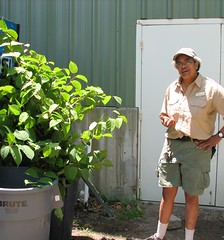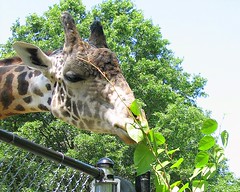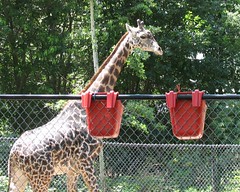Does being a blogger have its privileges? Perhaps. Last weekend, for example, I managed to use some connections to wrangle my way into the Franklin Park Zoo to see their cordoned-off giraffe exhibit up-close, under the guise of doing some invasive species reporting for the blog.
Actually, the trip was part of the massive knotweed extravaganza I was treating visiting photographer Koichi Watanabe to, in an effort to show him Japanese knotweed in Massachusetts in as many different habitats as possible. I had heard from a colleague a while ago that the Franklin Park Zoo was feeding knotweed to one of its giraffes, and the Roger Williams Zoo feeds it to their animals too, but I wanted to know more about it. Having Koichi here seemed like the perfect opportunity to find out.
So last Saturday my husband and I picked up Koichi, and the three of us met up with the Executive Director of the Franklin Park Coalition, Christine Poff, and active member Allan Ihrer. Before we headed to the zoo, Christine and Allan gave us a nice tour of the park...and when I say "nice" I mean "we saw so many different invasive plants my head was spinning" :-). There were a lot of native plants there too, and all in all the park is quite nice - I will definitely be heading back there for more visits this summer.
At noon Christine begged off, and the rest of our group headed over to the zoo and met up with Pearl Yusuf, the assistant curator for "Hooves and Horns." She took us down to the giraffes - surprisingly, through a locked gate! It turns out that the giraffe exhibit is currently under construction, and the public can only view the giraffes from afar. We lucked out and got to go right up to their pen.
There was already a bucket of fresh knotweed stems waiting nearby, next to a big pile of bundled dead stems, all of their leaves stripped off by hungry giraffes. Pearl started off by explaining the story behind the use of Japanese knotweed at the zoo. The zoo had been feeding knotweed to some of the animals for several years, as a treat. Then their male giraffe, Beau, developed a wasting disease, and turned down all kinds of food, until the Japanese knotweed finally perked his appetite back up. Since then, zookeepers have continued to feed knotweed to most of the hoofed animals at the zoo.Some of you are probably wondering whether Japanese knotweed provides the animals with a balanced diet...Allan in fact asked that very question. It turns out that it is not meant to - it is meant to provide a source of forage for the hoofed animals, ruminants who need a constant source of forage to keep their stomachs full and properly digest their food.
The giraffes are also fed a fortified food made with grains, alfalfa and beet pulp, to meet their main nutritional needs. That is what is in those red buckets hanging on the fence in the photo to the right.So where is all this Japanese knotweed coming from? Much of it is cut right from the adjacent Franklin Park. Lucky for the zoo, the park is infested with the stuff. That is where the Franklin Park Coalition comes in. Christine organizes teams to harvest the knotweed and the zoo comes by and scoops up piles of it to bring to the animals. They even end up freezing a lot of it so that they can continue to feed it to the giraffes through the winter months. Oddly, Beau loses his taste for Japanese knotweed around when it starts to flower, but will start eating it again at the end of the season after it has gone to seed. His mate, Jana, and their daughter, Autumn, aren't quite as picky.
A lesser news source might try to take the angle that this is going to solve the problem we have with invasive Japanese knotweed. But in reality, this isn't likely to make even the slightest dent in wild knotweed populations. In fact, the giraffes are fairly particular about how they'll eat it, and prefer long stems bundled together to mimic tree branches. To reduce Japanese knotweed growth in the wild by cutting, it has to be done several times per season, otherwise the rhizome biomass (the underground stems where the plant's resources are stored) would not be impacted. That would result in short, shrubby knotweed, something the giraffes would probably turn up their noses at.
But hey, if anyone knows where I can get a pet giraffe, we've got all this Japanese knotweed around, we might as well use it for something (they like autumn olive too!).




1 comment:
This is a great story! I want to find some large animal to eat Garlic Mustard...
Post a Comment